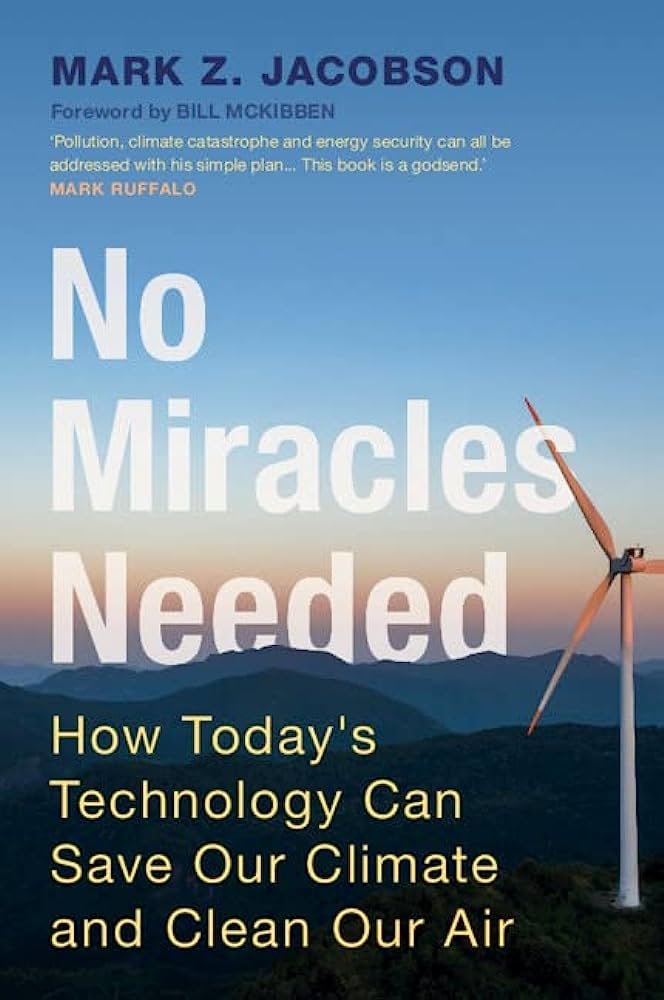
Fire Island, indeed Long Island, too, are on the front lines for the impacts of climate change.
“No Miracles Needed” is the title of a brilliant just-published book by Dr. Mark Z.
Jacobson, director of the Atmosphere/Energy Program and an engineering professor at Stanford
University in California. It’s subtitle: “How Today’s Technology Can Save Our Climate and Clean Our Air.”
“Adaption” and “resilience” have become key words.
But in medicine, the strategy is dealing with the cause of illness, not just treating the symptoms.
In “No Miracles Needed,” Dr. Jacobson, whose work has provided the key inspiration for New York State’s current energy plan, writes: “The world needs to switch away from using fossil fuels to using clean, renewable sources of energy as soon as possible. Failure to do so will lead to accelerated and catastrophic climate damage, loss of biodiversity, and economic, social, and political stability. We can solve the climate crisis, and at the same time eliminate air pollution and safely secure energy supplies for all — without using ‘miracle’ technology.”
He details the availability of “existing technologies to harness, store and transmit energy from wind, water, and solar sources to ensure reliable electricity and heat supplies.” And he discusses “which technologies are not needed”— including gas, carbon capture and nuclear power (the nuclear fuel cycle is carbon-intensive and nuclear plants themselves emit carbon, radioactive carbon).
In his book, Dr. Jacobson writes: “Why do we want to transition our worldwide energy system entirely to clean, renewable energy and storage for everything? This book first explores the three main reasons: to eliminate air pollution, global warming, and energy insecurity. Air pollution kills about 7 million people and injures hundreds of millions more each year world-wide. It is the second-leading cause of death. The impacts of global warming are accelerating as greenhouse gases and dark pollution particles in our atmosphere continue to increase. Such impacts include melting of glaciers and sea ice, rising sea levels, more droughts and floods, more intense hurricanes and wildfires, more air pollution and heat-related deaths and illnesses, agricultural shifts and famine, climate migration, species extinction, coral reef damage, and more. Lastly, fossil fuels are limited resources. As they run out, economic social and political stability will ensue. These three problems require an immediate and drastic solution.”
“Do we need miracle technologies? No,” he continues. “Then what is the solution? It is to transform to 100 % clean, renewable wind, water and solar (WWS) and storage for all energy purposes.”
He concludes his must-read book by saying: “The main barriers to a conversion to WWS worldwide are not technical, resource based, or economic. Instead, they are political and social.” He cites numerous places in the world that have already transitioned or are in the process of transitioning to wind, water and solar as energy sources.
He says: “When the 100 % WWS solution is finally implemented worldwide, the air pollution and climate problems outlined in this book will be relegated to the annals of history.”
To see a TV interview I did with Dr. Jacobson, visit www.envirovideo.com
A very, very dismal scenario for Fire Island and Long Island due to climate change was contained in a front-page article in April in Newsday headlined “LI’s Future and Climate Change” that ran for three pages. The depressing information: “In 2080, the historic Montauk lighthouse and Orient Point may be their own islands, cut off from the rest of Long Island by newly formed rivers.”
The next line: “At the end of the century, Fire Island may be little more than a sandbar separating the Atlantic from the Great South Bay.”
And the piece goes on: “And South Shore coastal neighborhoods from Freeport to Hampton Bays could be uninhabitable.”
The article, by Carl MacGowan, declared: “These are some of the likely scenarios for Long Island’s 1,600 miles of vulnerable shorelines, according to climate scientists and environmentalists, who, citing numerous studies, said rising ocean and bay tides will alter how Long Islanders live, work and play. The pace and severity of nature’s makeover is uncertain, and most of the Island — especially inland areas far from the coasts — will be spared the worst of it, experts said. But there is broad agreement that climate change will impact the island — and
residents and public officials must start planning for a flood-filled future.”
In the piece, Alison Branco, with the title of climate adaption director at The
Nature Conservancy office in Cold Spring Harbor, is quoted as saying: “It’s really hard to accept,
but the ocean is going to make that decision for us. It doesn’t mean we can’t live here. It’s just
going to look really different.”
“Over the next couple of decades, Long Island’s fish-shaped geography — with the North and South Forks as the tail — likely will be dramatically reconfigured,” says the piece. “On the South Fork, Napeague and Shinnecock bays could overwhelm the narrow strips of land that connect communities such as Hampton Bays, Amagansett and Montauk” — is Branco’s assessment. She says: “It’s really going to be a series of islands as opposed to the long peninsulas that we have now.”
The Newsday piece followed a report issued in March by Moody’s Analytics, a subsidiary of the Moody’s Corporation, which presents a list of “highest chronic physical risk among the 100 most populous areas” in the United States for the impacts of climate change. It starts with San Francisco, then Cape Coral, Florida, then New York City and in fourth place, Long Island.
The report does not specifically cite Fire Island, but says, “The New York City area and
Florida are especially vulnerable, but too are other parts of the Eastern Seaboard and California.” “The most at-risk metro areas are predominantly coastal,” it says.
The report says that “rising temperatures mean more frequent and severe natural disasters.”
A rapidly happening global disaster is at hand. Consider the series of the hottest days on Earth on record that have occurred this summer. As related in USA Today: “It comes as scientists say the planet is the hottest it has been in roughly 125,000 years.”
“We are hurtling towards disaster, eyes wide open,” UN Secretary General Antonio
Guterres said at a conference at the UN in New York in June. “It’s time to wake up and step up.”
Guterres, previously prime minister of Portugal, emphasized that central to the
climate crisis is the burning of fossil fuels. He repeated the call he and others have made over
and over again: the burning of fossil fuels — coal, oil and gas — must be eliminated with a rapid
transition to green, renewable energy.
The technologies are here now to do that as detailed in “No Miracles Needed.”































